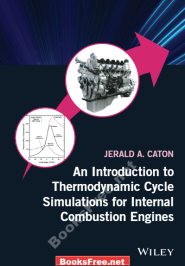| Book Name: | Introduction to Thermodynamic Cycle Simulations for Internal Combustion Engines By Jerald A Caton |
| Free Download: | Available |

| E-book Particulars : | |
|---|---|
| Language | English |
| Pages | 384 |
| Format | |
| Dimension | 11 MB |
Introduction to Thermodynamic Cycle Simulations for Internal Combustion Engines By Jerald A Caton
Using engine cycle simulations is a vital side of engine improvement, and but there may be restricted complete documentation out there on the formulations, answer procedures, and detailed outcomes. Since starting within the 1960s, engine cycle simulations have developed to their present extremely subtle standing. With the concurrent improvement of quick and available computer systems, these simulations are utilized in routine engine improvement actions all through the world. This ebook supplies an introduction to primary thermodynamic engine cycle simulations and supplies a considerable set of outcomes. This ebook is exclusive and supplies plenty of options not discovered elsewhere, together with:
● complete and detailed documentation of the mathematical formulations and options required for thermodynamic engine cycle simulations;
● full outcomes for instantaneous thermodynamic properties for typical engine cycles;
● self-consistent engine efficiency outcomes for one engine platform;
● a radical presentation of outcomes based mostly on the second regulation of thermodynamics;
● the usage of the engine cycle simulation to discover a lot of engine design and working parameters by way of parametric research;
● outcomes for superior, excessive effectivity engines;
● descriptions of the thermodynamic options that relate to engine effectivity and efficiency;
● a set of case research that illustrate the usage of engine cycle simulations—these case research think about engine efficiency as capabilities of engine working and design parameters;
● an in depth analysis of nitric oxide emissions as capabilities of engine working parameters and design options.
Though this ebook focuses on the spark-ignition engine, the vast majority of the event and most of the outcomes are relevant (with modest changes) to compression-ignition (diesel) engines. In reality, the foremost distinction between the 2 engines relates to the combustion course of, and these variations are largely associated to the small print and never the general course of. However to be constant, extrapolations to compression-ignition engines are largely prevented. The examples and case research are based mostly on an automotive engine, however the procedures and most of the outcomes are legitimate for different engine classifications. As well as, the thermodynamic simulation may very well be used for these different purposes. Lots of the outcomes are pretty common and can be relevant to most engines. For instance, outcomes highlighting the problem of changing thermal power into work (a consequence of the basic thermodynamics) applies to all engines.
Related More Books
See More POST On : Mechanical Books



